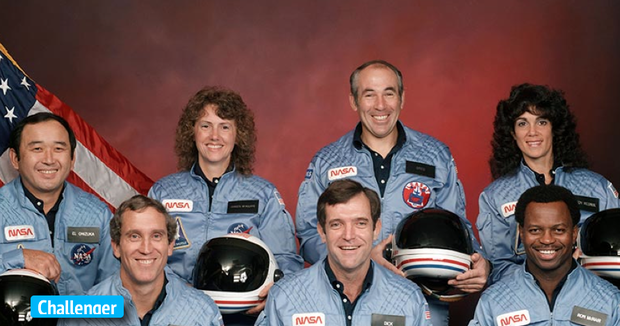The Challenger disaster: 33 years ago I was working at mission control

Thirty-three years ago I was at mission control at NASA's Goddard Space Flight Center for the launch of the Challenger. I was working data communications. My job was making sure all the telemetry links between the space shuttle and NASA's ground communications system (NASCOM) were working. Everything was green on my board, the shuttle launched, and a few seconds later everything went to hell. I stared at my controls, tried to get things to reconnect, and then I finallly looked up at the TV display.

Challenger crew.
You know what I saw. We all saw it that day.
Featured
Throughout schools, kids from kindergartners to high school students were ready to watch Sharon Christa McAuliffe, the first teacher in space, launch into orbit. Instead they saw a tragedy.
By 1986, space flight had become passe. Most assumed that the space shuttle could be counted on to launch flawlessly time after time. There had been disasters. Most Americans didn't know about Soyuz 1's parachute failure or the decompression of Soyuz 11.
Apollo 13? We got our astronauts back. Apollo 1? That happened in a ground test and made little impact outside NASA circles.
Challenger exploded in front of our eyes.
Later we learned that it could have been prevented. Roger Boisjoly, an engineer working at Morton Thiokol, the solid rocket boosters manufacturer, has written a memo predicting a potential "catastrophe of the highest order" of the boosters' O rings. This would lead to a real chance of "losing a flight." He was ignored by both Morton Thiokol and NASA and seven brave people died.
They wouldn't be the last.
On February 1st, 2003, the shuttle Columbia broke up on re-entry.
Once more a technical problem, a problem with external tank foam insulation, management mistakes and poor internal communications combined to lead to the death of seven more astronauts.
Some would say, and I can't argue with them, that it was also the end of the Shuttle program and the U.S. manned space program. Today we still have Americans in orbit on the International Space Station (ISS), but they're hitchhikers on Russian spaceships.
SpaceX's Dragon spacecraft in pictures
Long before then, NASA's manned spaceflight initatives were doomed. Even when I worked at NASA in the 80s, we were making do with hopelessly outdated equipment. One of the tertiary communication links I monitored in 1984 was a Telex line dating back to the 1950s to the Bermuda tracking station.
Why? Because once the space race to the moon was won, America never wanted to spend money on space. NASA's billions only look big when they're taken out of context. NASA's budget makes up a mere 0.5 percent of the Federal budget.
Today, manned space flight's future belongs to the private sector. If we ever get beyound Near-Earth Orbit (NEO), it will be because of companies such as Jeff Bezos's Blue Origin, Elon Musk's SpaceX, and Sir Richard Branson's Virgin Galactic.
When, if, we do, we'll have more deaths. We'll try to get it right and sometimes we will fail.
The price of exploration is always paid in blood.
January 28th 1986 was one of the worst days of my life. But, if we are ever to leave this island Earth -- and I believe we must to survive as a species -- there will be more such days. The price is high, but worth it.
Related Stories
- NASA shows the world its 20-year virtual reality experiment to train astronauts: The inside story TechRepublic
- Clearing up space junk: The system that's ready to decommission satellites before they even launch
- NASA 60th anniversary: All about the space agency's past, present and future CNET
- Branson: Our kids will be astronauts